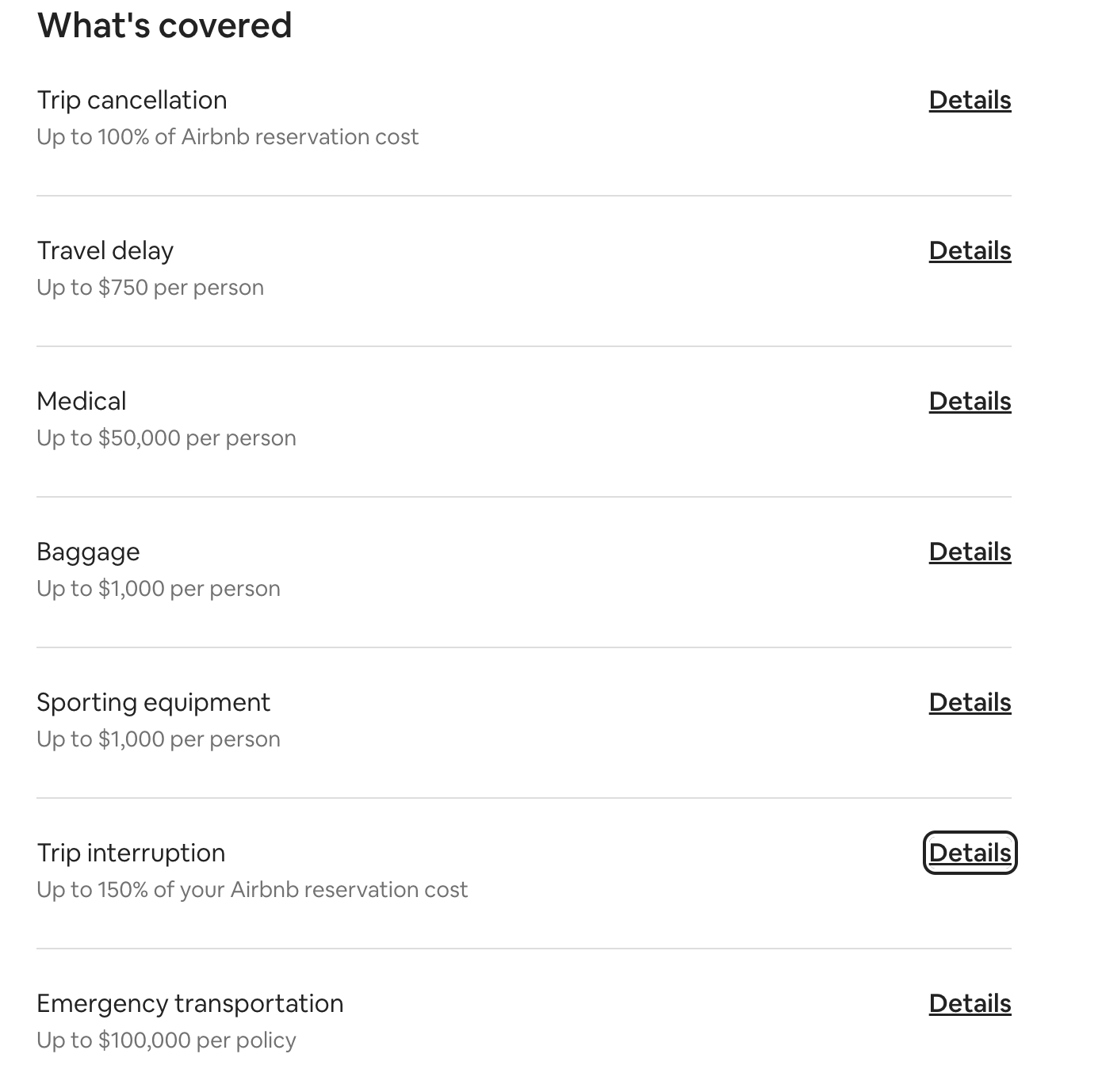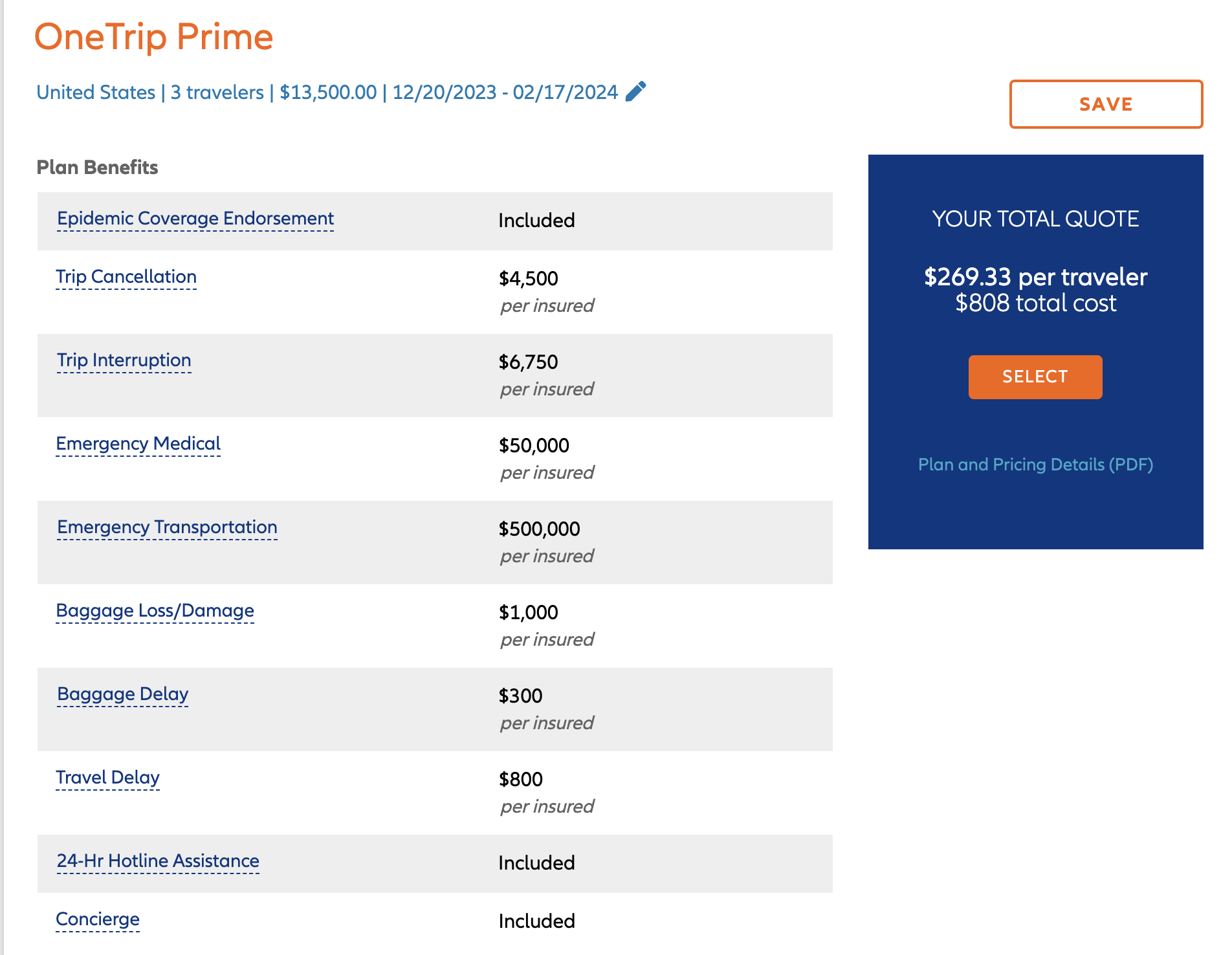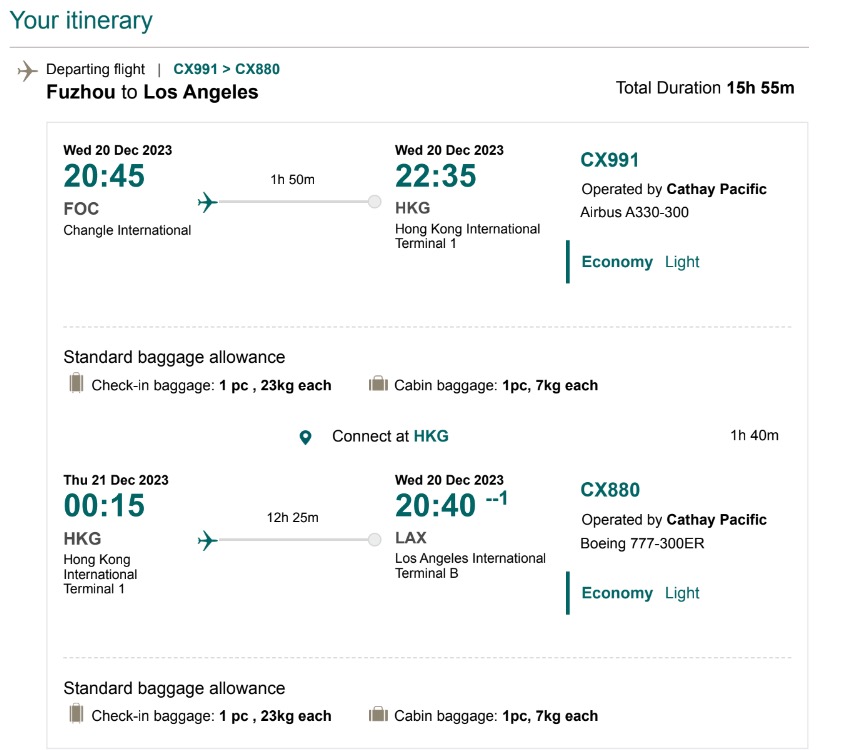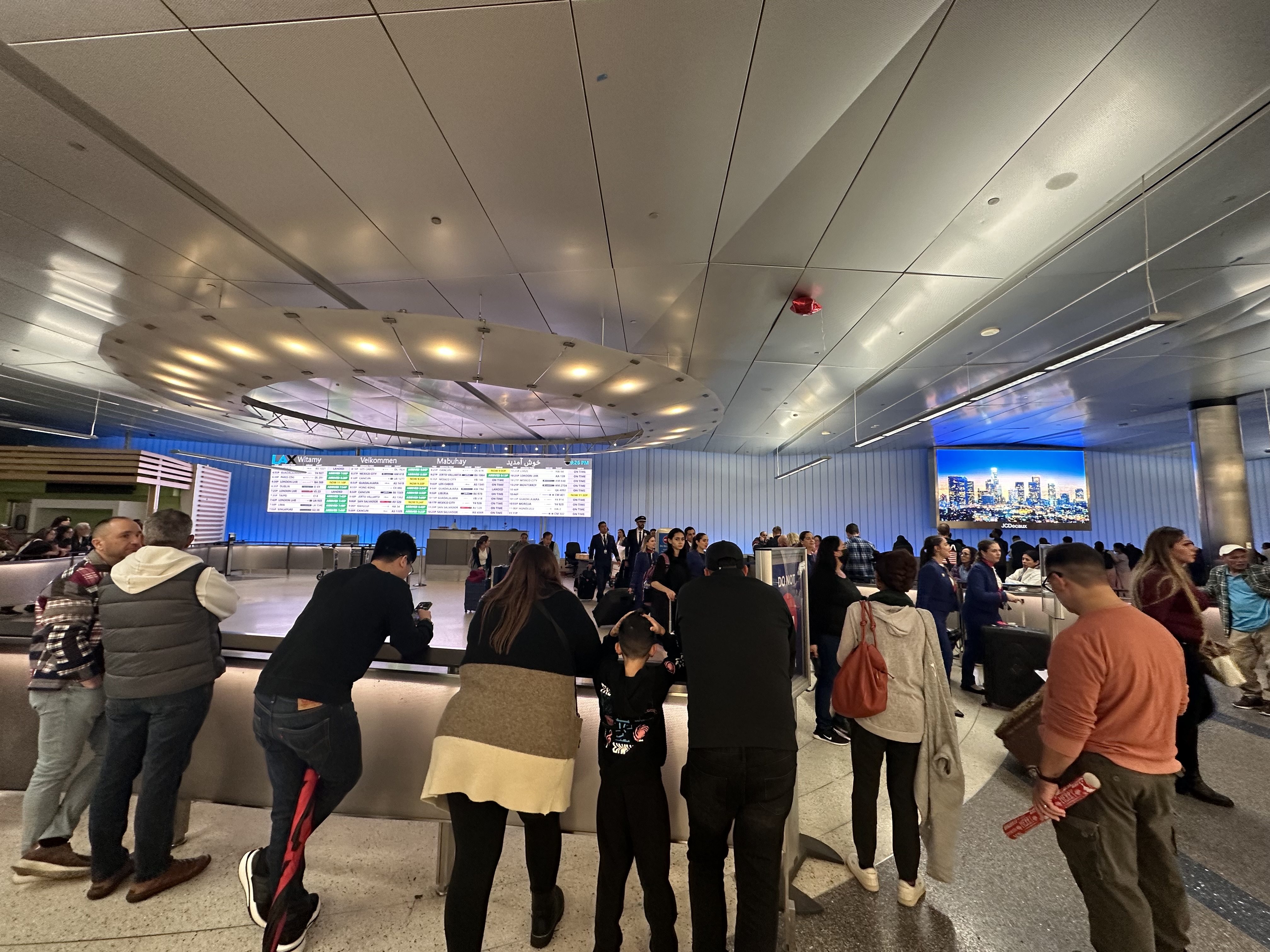Parents' Trip to the U.S. - Insurance, Flights, and Entry
This content was automatically generated by gpt-4o-mini (No human review). The original post is in Chinese.
This blog discusses the preparations and entry experiences of my parents and younger brother’s trip to the U.S.
Travel Insurance
Airbnb Travel Insurance
In the previous post about Parents’ Trip to the U.S.: Accommodation Issues, I mentioned that I ultimately purchased Airbnb’s travel insurance for $400. The main reason was to ensure that I could get a refund for accommodation costs in case of unexpected trip cancellations. However, Airbnb’s insurance actually covers other aspects as well: trip cancellations and delays, medical expenses, luggage delays and losses, etc. (as shown in the image below). This insurance covers everyone staying at the Airbnb (I selected 5 people, including myself and Cuihao). Besides the refund for Airbnb accommodation, what I valued most was the $50,000 medical insurance per person, which can reimburse expenses for hospital visits, hospitalization, prescribed medications, tests, etc., in case of illness. One unreliable aspect is that when purchasing the insurance, I didn’t need to fill in any information about the insured individuals, such as names, ages, IDs, etc. This means I could actually modify the guest information on Airbnb and insure different people. Since there were no incidents in the end and I didn’t file a claim, I have no idea how the claims experience with Airbnb’s insurance would be.

I also looked into other travel insurance options, such as my former employer Allianz. By entering the ages of three people and the travel dates, along with estimated expenses, they can provide a quote for the premium, as shown in the screenshot below. The premium here is more expensive than Airbnb’s (a total of $808 for three people), but the reimbursement limits are actually similar to Airbnb’s. In comparison, I decided to go with Airbnb’s insurance.

Domestic Overseas Travel Insurance
But later I realized that I overlooked a problem: Airbnb’s insurance only covers the time we stay at the Airbnb, and my parents did not have insurance during their stay in the U.S. at the Airbnb, which is why the price was relatively cheap. So after thinking it over, I decided to buy a separate insurance policy that covers from 12/20/2023 to 1/2/2024. I purchased the China Ping An Ping An Travel Insurance (Overseas), and the total cost for three people was 750 RMB, just for peace of mind. In the end, my parents’ flight to the U.S. had a checked bag delayed for over 24 hours, and we claimed 1200 RMB, which made up for the cost. The claims experience was decent; I downloaded the app, submitted the claim information on my phone, and after waiting many days with no progress, I contacted customer service through the app to follow up. That same day, someone emailed us asking for a photo of the boarding pass, and after sending the documents, we received the claim money a few days later.
Credit Card Insurance
During my search for travel insurance, I learned that many credit cards offer free travel insurance as long as you use that credit card to purchase tickets, pay for accommodations, etc. One requirement is that the insured must be the credit card holder themselves, their spouse, or immediate family members. In short, you can check which of your credit cards offer travel insurance and what it covers. For example, most cards have insurance for flight delays and cancellations, but they may not cover medical expenses for seeing a doctor or getting medication.
Fortunately, my parents and younger brother did not get sick during their time in the U.S., so we did not use the medical reimbursement part of the travel insurance, and I don’t know how the claims process would have been for that.
Air Tickets
As early as the end of 2019 and the beginning of 2020, I started paying attention to the prices of flights between China and the United States, mainly from Shanghai to Los Angeles (PVG - LAX). The prices back then were very cheap.
- At the end of 2019 (2019/12/29), I looked for flights for the summer of 2020 (2020/7/19), and Delta’s direct round-trip ticket from Shanghai to Los Angeles was only $491 per person.
- At the beginning of 2020 (2020/1/9), I checked again for the summer of 2020 (2020/7/19), and Delta’s direct round-trip ticket from Shanghai to Los Angeles was only $606 per person.
Later, as the pandemic developed, flights between China and the U.S. drastically decreased, and the price of direct tickets once soared to $5,000 or $6,000 each. Due to the high ticket prices and strict domestic pandemic controls, I never considered bringing my parents to the U.S. It wasn’t until 2023 that ticket prices began to gradually decline, but they were still far from the prices before the pandemic. Since my parents obtained their U.S. travel visas in March, I bought tickets for my parents and younger brother to come to the U.S. at the beginning of June 2023 for their trip in late December. I purchased economy class tickets with Cathay Pacific, and the total for three one-way tickets was $2,234.46. The flight departs from Fuzhou Changle, transfers in Hong Kong, and flies to Los Angeles, taking a total of 15 hours and 55 minutes. Although it’s not a direct flight, the time isn’t too long. Mainly, my family is in Ningde, and taking a high-speed train from Ningde to Shanghai takes 5-6 hours, and we might need to go to Shanghai a day early and stay overnight. It’s more convenient to take an airport bus directly from Ningde to Fuzhou Changle Airport, which only takes 2 hours. Therefore, the total travel time from my home in Ningde to my final destination in Irvine would not exceed 24 hours. Later, I realized that I had actually bought the tickets too early; if I had waited until November, I could have saved about $100 per person.

I initially didn’t plan to buy return tickets to China in advance because I wasn’t sure if my parents and brother would adapt to life in the U.S. or stay for two months, so the return date was uncertain. However, considering that it’s better to have a return ticket when entering the U.S., we decided to buy tickets for their return to China in early December, for February 15, 2024. We purchased economy class tickets with Xiamen Airlines, flying directly from Los Angeles to Xiamen, taking 15 hours and 15 minutes, and the total for three one-way tickets was $2,156.90. As expected, due to the relatively boring life in the U.S., high accommodation costs, and our busy work schedules, my parents ultimately decided to return home early and not spend the New Year in the U.S. The experience on the Xiamen Airlines website was very poor; I couldn’t change the tickets online at all, so I called customer service to change the date. The total fee for changing the three tickets was $365.95.

Pre-Trip Preparation
Because I consider my parents coming to the United States to be extremely important (there’s a lot of pressure and anxiety), we made extensive preparations, almost like a nanny-style, hands-on approach to help my parents and younger brother get ready for the trip. In the one or two weeks leading up to their arrival in the U.S., I communicated with my parents via WeChat video almost every day. The preparations I made included, but were not limited to:
- As mentioned earlier: booking accommodations, purchasing travel insurance, and buying round-trip tickets in advance.
- EVUS system information registration (very important)
- Updated the travel itinerary and invitation letter (previously for the visa officer, now for the immigration officer, and the flight information and travel dates have also been updated).
- Taught my parents how to connect to the LAX airport Wi-Fi (so they can contact us via WeChat after getting off the plane).
- Instructed my parents to download the airline app on their phones to check flight status.
- Sent my parents some videos to learn travel English, familiarize themselves with the customs process, and understand how to fill out the customs declaration form.
- Discussed with my parents what luggage to bring to the U.S. (clothes suitable for the weather here, enough medication for two months, and important documents).
- Ensured my parents set up international roaming on their mobile phones, obtained a credit card that can be used abroad, and exchanged some cash in $10 and $20 bills (around $100-200).
- Sent my parents organized materials for them to print and carry, including:
- Round-trip flight itinerary
- Airbnb accommodation receipt
- Travel itinerary and invitation letter
- Visa system registration record
- Checked in for the flight 24 hours in advance.
- Did a thorough cleaning and organized the apartment.
Entering the United States
Before my parents entered the United States, I was quite nervous, fearing that something might go wrong. On one hand, their English is really poor; they only know some very basic words. On the other hand, even if you have a visa, you can still be denied entry and sent back. So, I asked my parents to send us a message before they got on the plane, and once they landed and connected to the airport Wi-Fi, to contact us immediately. Their flight was scheduled to arrive at Los Angeles Airport around 8 PM, and we left Irvine around 6 PM to drive there. There was some traffic, and it took us about two hours to reach the airport. Once we arrived, Cuihao stayed in the car while I circled around the airport. I got out and went into the terminal, waiting in the hall designated for international arrivals (as shown in the picture below).

I waited for about 30 minutes when my parents and younger brother came out. We immediately saw each other, and after a brief hug and some small talk, we exited the airport terminal and contacted Cuihao to come pick us up, then drove home. The drive back from LAX was smooth, taking only about 50 minutes to get home.
In the car, I asked my parents about their experience entering the country. Their flight landed 50 minutes early, and after disembarking, they quickly connected to Wi-Fi and sent us a message on WeChat. Then they queued for customs. For some reason, they didn’t actually fill out the customs declaration form. The line for customs was very long, and they waited for about an hour. Some staff noticed they had a small child with them and took them to a faster line, saving them quite a bit of waiting time. The questions from customs were also very simple; my parents showed their travel plans and invitation letter, and they were even complimented on how well-prepared their documents were. Overall, the entry experience was very smooth. My dad said the staff were all very friendly, and not speaking English wasn’t a big issue.
Luggage Delay
On the way to the airport, I received a call from Cathay Pacific, saying that my dad’s suitcase did not make it onto the plane and was still in Fuzhou/Hong Kong. It wouldn’t arrive tonight but would reach Los Angeles tomorrow, and they would send someone to deliver it to our home in Irvine. They then confirmed my email and address, saying I would receive an email later. However, by the next day, I still hadn’t received any email, nor had any delivery service contacted me. By three or four in the afternoon, with no updates, we started calling Cathay Pacific because my dad had put his high blood pressure and diabetes medication in the suitcase, which he needed to take daily. Cathay Pacific kept saying they couldn’t find any information about the suitcase and told us to contact the staff at Los Angeles airport. They only provided me with several phone numbers, but none of them worked, and I couldn’t reach the airport ground staff at all. Finally, by 8 PM, still without our luggage, Cuihao drove to Los Angeles airport in the rain. Once there, he found the Cathay Pacific counter staff, and within 10 minutes, he located my dad’s suitcase and brought it home.
This experience made us feel that Cathay Pacific’s customer service is really poor, and the attitude on the customer service line was also terrible. The website is poorly designed, and a lot of information is unavailable, unlike Delta’s website, where you can directly check the status of your luggage. In the end, we spent a lot of time submitting compensation information and communicating via email, and only then did Cathay Pacific finally compensate us $200. A lesson learned: never put daily medication in checked luggage.

